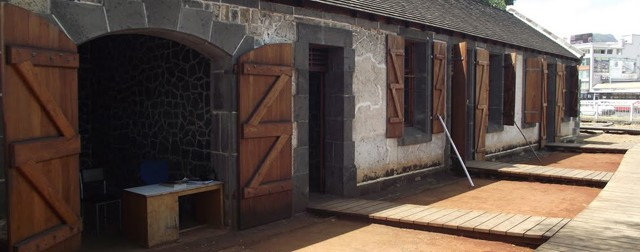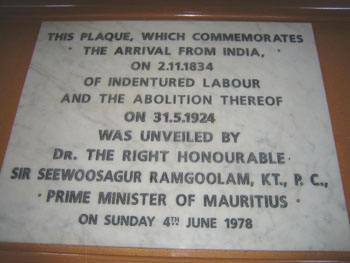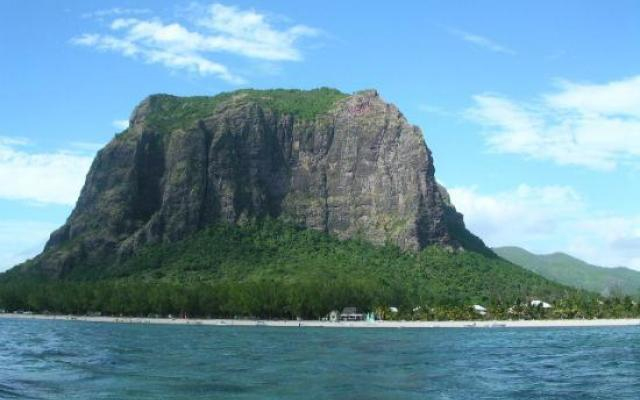*By Ambassador Bhaswati Mukherjee
 (A dilapidated complex of buildings at Aapravasi Ghat in Port Louis) Towards the establishment of an International Indentured Labour Route
(A dilapidated complex of buildings at Aapravasi Ghat in Port Louis) Towards the establishment of an International Indentured Labour Route
An international Conference with Ministerial level participation from India is being held in Port Louis, Mauritius, from 2nd to 4th November, 2014 to mark the 180th Anniversary of the first arrival of Indian indentured labour in Mauritius at Aapravasi Ghat on 2nd November 180 years ago. It will trace the journey of the indentured labour from India to Mauritius after the abolition of slavery in 1834, a journey which poignantly highlights the history of modern Mauritius itself which is entwined with our own history. It marks the point where the indentured labour, drawn mainly from Bihar and Uttar Pradesh provinces but also from Southern Provinces of colonial India, passed through the gate of Aapravasi Ghat, either to stay on in Mauritius to work as indentured labour in the sugar plantations or elsewhere, or to sail on to further destinations, such as Guyana, Suriname and Reunion Island. As India’s President, His Excellency Pranab Mukherjee said during his last visit to Mauritius on 12 March 2013:
The visit to this historic Heritage site of Aapravasi Ghat, where brave men and women from India and other shores first set foot in Mauritius when they arrived here more than 175 years ago, would remain etched in my memory. Aapravasi Ghat represents, in the most sublime way, the triumph of the human spirit in the face of all odds. It stands as a monument to the memory of these valiant men and women. Their immense courage, will and perseverance have shaped the Mauritius of today
 (A commemorative Plaque at Aapravasi Ghat in Mauritius) This Conference, chaired by the Prime Minister of Mauritius, where our External Affairs Minister will be an honoured guest and will deliver an important statement, is a timely initiative. It complements the Slave Route Project which also relates to the movement of a mass of people across continents. It will pay homage to these memories, of the pain and suffering endured by more than 462,000 men, women and children, mainly from India but also from many other countries in different parts of the Indian Ocean world, who set foot on Mauritian shores at Aapravasi Ghat. Mauritius is unique for another reason. It is the only country in the world that has two UNESCO sites, one dedicated to resistance to slavery, Le Morne, and the other to indentured labour, the Aapravasi Ghat. Clearly, such a dialogue on the global post-colonial heritage, of both slavery and indentured, contributes to the universal dialogue on Humanism of Diversity, since it promotes a better understanding of the common cultural and civilizational links between peoples and thus strengthens cultural diversity and enriches humanity.
(A commemorative Plaque at Aapravasi Ghat in Mauritius) This Conference, chaired by the Prime Minister of Mauritius, where our External Affairs Minister will be an honoured guest and will deliver an important statement, is a timely initiative. It complements the Slave Route Project which also relates to the movement of a mass of people across continents. It will pay homage to these memories, of the pain and suffering endured by more than 462,000 men, women and children, mainly from India but also from many other countries in different parts of the Indian Ocean world, who set foot on Mauritian shores at Aapravasi Ghat. Mauritius is unique for another reason. It is the only country in the world that has two UNESCO sites, one dedicated to resistance to slavery, Le Morne, and the other to indentured labour, the Aapravasi Ghat. Clearly, such a dialogue on the global post-colonial heritage, of both slavery and indentured, contributes to the universal dialogue on Humanism of Diversity, since it promotes a better understanding of the common cultural and civilizational links between peoples and thus strengthens cultural diversity and enriches humanity.
 (Le Morne, a UNESCO recognized World Heritage Site of Mauritius) How did it begin? With the abolition of slavery in 1833 in Britain and with its implementation in 1835 in Mauritius, the British turned to India to work on the sugar plantations to perpetuate their colonial domination in the hey-day of the industrial revolution and the nascent days of capitalism. There started to be written in the annals of human history one of the most massive migrations of Indian labour. It marks the beginning of an odyssey across theKalapani, a sad journey of exile across the tempest tossed Indian Ocean. The recruiters known asSirdarsorMistries played their role in luring away these credulous, innocent coolies, many of whom believed that theMirich Desh (Mauritius) was just to the north of North India. What is the nature of indenture? The Oxford English Dictionary defines it as a formal agreement binding an apprentice to a master, or a contract by which a person agrees to work for a set period for a colonial land-owner. Thus, the indenture was not based on the principle of equality or natural justice. However, the Great Experiment, as it was called, which was first established in Mauritius in 1834 was deemed to be a great success by the former colonial powers. It resulted in the former colonial countries to recruit indentured labour in other parts of the world for their colonies. Today these independent States comprise some of the 22 countries on the International Indentured Labour Route Project.
(Le Morne, a UNESCO recognized World Heritage Site of Mauritius) How did it begin? With the abolition of slavery in 1833 in Britain and with its implementation in 1835 in Mauritius, the British turned to India to work on the sugar plantations to perpetuate their colonial domination in the hey-day of the industrial revolution and the nascent days of capitalism. There started to be written in the annals of human history one of the most massive migrations of Indian labour. It marks the beginning of an odyssey across theKalapani, a sad journey of exile across the tempest tossed Indian Ocean. The recruiters known asSirdarsorMistries played their role in luring away these credulous, innocent coolies, many of whom believed that theMirich Desh (Mauritius) was just to the north of North India. What is the nature of indenture? The Oxford English Dictionary defines it as a formal agreement binding an apprentice to a master, or a contract by which a person agrees to work for a set period for a colonial land-owner. Thus, the indenture was not based on the principle of equality or natural justice. However, the Great Experiment, as it was called, which was first established in Mauritius in 1834 was deemed to be a great success by the former colonial powers. It resulted in the former colonial countries to recruit indentured labour in other parts of the world for their colonies. Today these independent States comprise some of the 22 countries on the International Indentured Labour Route Project.
 (Remains of kitchen block at Aapravasi Ghat in Mauritius) With this background, it was only fitting that Aapravasi Ghat should be inscribed on the World Heritage List since it fulfils criteria (vi) of UNESCO’s Operational Guidelines. The Decision adopted (30 COM 8B.33) in its Operative Paragraph 2 states:
(Remains of kitchen block at Aapravasi Ghat in Mauritius) With this background, it was only fitting that Aapravasi Ghat should be inscribed on the World Heritage List since it fulfils criteria (vi) of UNESCO’s Operational Guidelines. The Decision adopted (30 COM 8B.33) in its Operative Paragraph 2 states:
Aapravasi Ghat, as the first site chosen by the British Government in 1834 for the ‘great experiment’ in the use of indentured, rather than slave labour, is strongly associated with memories of almost half a million indentured labours moving from India to Mauritius to work on sugar canes plantations or to be transhipped to other parts of the World.
As Ambassador of India to UNESCO and India’s Representative on the World Heritage Committee, I was privileged to argue the case for the African Group and for Mauritius at the Meeting of the Committee in Vilnius, Lithuania, in 06. Despite efforts by the Advisory Body to argue that there was no Indentured Route and that the Indian labour coming to Mauritius and other destinations were seeking a better future through modern immigration, Mauritius and India convincingly made the case as explained above that indentured labour’s passage to Aapravasi Ghat could not be compared with modern immigration as we understand it and that its OUV [Outstanding Universal Value] was intact and represented a significant historic memory to the world, similar to the Slave Route. Accordingly, and despite a negative recommendation given by the Advisory Body, this site was inscribed by acclamation, representing a great victory for India and Mauritius and also for international recognition of the indentured labour heritage. The World Heritage Committee also recommended that Mauritius, as the concerned State Party and other interested States, specially India, undertake research on indentured labour to understand its scope and impact globally and to consider the possibility of inscribing the Aapravasi Ghat archives for UNESCO’s Memory of the World Register. This Conference marks an effort to carry these recommendations forward.
This Conference represents an important step forward in the quest to understand the global nature of the phenomenon of indenture. This Conference fulfils the need for the indentured experience in other countries to be better known. The International Indentured Labour Route will bring together all countries having experienced the migration of contractual labour in the 19th century when the world economic order was being transformed in the manner we know it today and to create a network of persons, institutions who will collaborate, share and disseminate knowledge about the indentured system, the history and culture of its descendants and contribute to the nation building process in their countries as appropriate.
It is unfortunate that scholarship in this field of inquiry is marked by the frequent failure of scholars and intellectuals to transcend the geographical and conceptual parochialism that has become a hallmark of contemporary plantation studies in general and indentured labour studies in particular. Equally unfortunate is the lack of interest internationally in the Indentured Labour Route, despite its acknowledged role in shaping the contours of socio-economic, cultural, and political life and contributing to vibrant democracy such as in Mauritius, in the post-colonial era. This Conference will help to highlight the need for the constitution of an international network of scholars working on indentured labour for the purpose of fostering new perspectives on these systems and deepening our understanding of the indentured experience in all its complexity.
The expected outputs of the Indentured Labour Route Project which are of direct relevance to India are to:
- Encourage the development of research and the setting up of a documentation centre and database on the indentured labour migration across the world;
- Create a network of persons, institutions who will collaborate, share and disseminate knowledge about the indentured system, the history and culture of its descendants ;
- Locate and preserve cultural heritage sites relating to indenture and place them on the Indenture Route;
The Conference with India’s support will address many difficult issues, to better understand the legacy of indentured labour, both in the countries of origin and their final destination in the social, economic and cultural context. It will reflect on the nature of post-indentured identity formation in different parts of the world and how it is leading to the development of trans-national identities in the world of today and finally, what has been the relationship between indentured labour and ethnocentrism i.e. the need to prevent ethnic labelling and stereotyping so as to prevent development of ethnic boundaries, a development that has been closely studied by the scholars of the Slave Route.
The Conference underlines the continuing validity of Mahatma Gandhi’s rejection of both slavery and indenture. Gandhiji said :
How can one be compelled to accept slavery?
I simply refuse to do the master’s bidding.
He may torture me, break my bones to atoms and even kill me.
He will then have my dead body, not my obedience.
Ultimately, therefore, it is I who am the victor and not he,
For he has failed in getting me to do what he wanted done.
 (Ambassador Bhaswati Mukherjee)*[The author, a former diplomat, was Permanent Representative of India to UNESCO (2004-2010). This article has been written exclusively for the ‘In Focus” section of Ministry of External Affairs’ website,www.mea.gov.in]
(Ambassador Bhaswati Mukherjee)*[The author, a former diplomat, was Permanent Representative of India to UNESCO (2004-2010). This article has been written exclusively for the ‘In Focus” section of Ministry of External Affairs’ website,www.mea.gov.in]